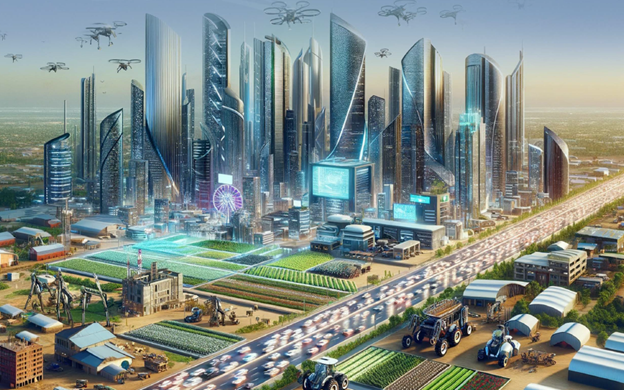
Highlights
• The current 2.5% GDP growth is clearly below what Nigeria needs to address multidimensional macroeconomic challenges confronting the nation. Slow economic growth can have various negative impacts on socio-economic development. .
• The five largest economic sectors in Nigeria (Agriculture, Manufacturing, Trade, ICT and Construction) accounts for 73.6% of the GDP. These sectors have the capacity to drive the desired economic growth in Nigeria in the mid-to-long term.
• We consider a 5% – 7% annual real GDP growth as the minimum Nigeria should target over the next decade, assuming the population growth rate remains flat at 2.4%. Our analysis shows that sustaining this growth rate could deliver a $900 – $1,100 billion economy by 2033.
• To achieve a $1 trillion economy by the year 2033, the country needs to achieve and sustain a minimum of 6.5% average annual GDP growth rate and implement policies to slow the population growth rate sustainably.
• In the short-term, government must stabilize the economy, optimize quick wins, and show strong political will to act. Long term strategies must address infrastructure gaps, population growth rate, prioritize private sector participation and the development of needed human capital through investment in health, education, nutrition, and social services.
What are the drivers of economic growth in Nigeria?
Over the last decade, economic growth in Nigeria has been driven by the non-oil sector, particularly the services sector which now accounts for 52.70% of the GDP. Nonetheless, this sector has been growing at a decreasing rate, from 7.4% in Q1 2022 to 3.99% as of Q3 2023. Similarly, agriculture sector is another major driver of growth in Nigeria, accounting for 29.3% of the GDP and 35% of aggregate employment, but has sustained a slow and volatile growth (1.30% in Q3 2023) over the last decade. The industry sector expanded by 0.46% in Q3 2023, compared to an 8.0% contraction recorded in the third quarter of 2022.
What economic growth rate does Nigeria need to attain?
We consider a 5% – 7% annual real GDP growth as the minimum Nigeria should realistically target in the next decade. Our analysis shows that sustaining this growth rate should deliver a $700 – $800 billion economy by 2033. We believe strongly that Nigeria has the potential to achieve this target economic growth given its abundant natural resources, large and youthful population, and diverse economic sectors. To achieve a $1 trillion economy by the year 2033, the country needs to achieve and sustain 6.5% minimum average GDP growth rate and implement policies to slow the population growth rate sustainably.
Scenario Analysis – Real GDP by the year 2033
We took a bottom-up approach to see how growth in key economic sectors can drive desired aggregate GDP growth over the next decade under six scenarios. The results from this analysis further buttress our position that the country needs to achieve and sustain a 5% - 7% GDP to deliver desired economic outcomes. To achieve this performance, the agriculture and manufacturing sectors need to each sustain a 4% - 6% average annual growth, the construction sector must grow at 8% - 10%, whilst the ICT sector must grow at 12% - 14% on average, over the next decade.
Call to Action - the role of government and policy makers
The Nigerian government and policy makers have a crucial role in driving the desired 5% – 7% GDP growth over the next decade. The federal government must take the lead, formulate, and implement visionary policies that will guide all economic actors towards achieving sustainable growth. Such policies must address economic, social, and institutional drivers of economic growth, whilst ensuring that the growth outcomes are broad-based, non-inflationary and inclusive. To sustain growth in the long-term, the government needs to continue the roll-out of visionary infrastructure projects that will support economic diversification, broad-based growth, and better quality of life.

